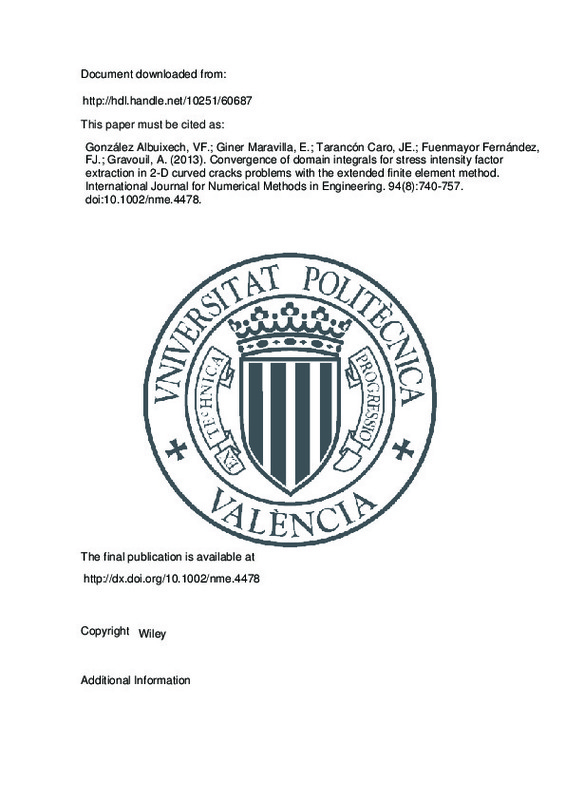Mo�s, N., Dolbow, J., & Belytschko, T. (1999). A finite element method for crack growth without remeshing. International Journal for Numerical Methods in Engineering, 46(1), 131-150. doi:10.1002/(sici)1097-0207(19990910)46:1<131::aid-nme726>3.0.co;2-j
Sukumar, N., Mo�s, N., Moran, B., & Belytschko, T. (2000). Extended finite element method for three-dimensional crack modelling. International Journal for Numerical Methods in Engineering, 48(11), 1549-1570. doi:10.1002/1097-0207(20000820)48:11<1549::aid-nme955>3.0.co;2-a
Moës, N., Gravouil, A., & Belytschko, T. (2002). Non-planar 3D crack growth by the extended finite element and level sets-Part I: Mechanical model. International Journal for Numerical Methods in Engineering, 53(11), 2549-2568. doi:10.1002/nme.429
[+]
Mo�s, N., Dolbow, J., & Belytschko, T. (1999). A finite element method for crack growth without remeshing. International Journal for Numerical Methods in Engineering, 46(1), 131-150. doi:10.1002/(sici)1097-0207(19990910)46:1<131::aid-nme726>3.0.co;2-j
Sukumar, N., Mo�s, N., Moran, B., & Belytschko, T. (2000). Extended finite element method for three-dimensional crack modelling. International Journal for Numerical Methods in Engineering, 48(11), 1549-1570. doi:10.1002/1097-0207(20000820)48:11<1549::aid-nme955>3.0.co;2-a
Moës, N., Gravouil, A., & Belytschko, T. (2002). Non-planar 3D crack growth by the extended finite element and level sets-Part I: Mechanical model. International Journal for Numerical Methods in Engineering, 53(11), 2549-2568. doi:10.1002/nme.429
Gravouil, A., Moës, N., & Belytschko, T. (2002). Non-planar 3D crack growth by the extended finite element and level sets-Part II: Level set update. International Journal for Numerical Methods in Engineering, 53(11), 2569-2586. doi:10.1002/nme.430
Sukumar, N., & Prévost, J.-H. (2003). Modeling quasi-static crack growth with the extended finite element method Part I: Computer implementation. International Journal of Solids and Structures, 40(26), 7513-7537. doi:10.1016/j.ijsolstr.2003.08.002
Huang, R., Sukumar, N., & Prévost, J.-H. (2003). Modeling quasi-static crack growth with the extended finite element method Part II: Numerical applications. International Journal of Solids and Structures, 40(26), 7539-7552. doi:10.1016/j.ijsolstr.2003.08.001
Rice, J. R. (1968). A Path Independent Integral and the Approximate Analysis of Strain Concentration by Notches and Cracks. Journal of Applied Mechanics, 35(2), 379-386. doi:10.1115/1.3601206
Moran, B., & Shih, C. F. (1987). Crack tip and associated domain integrals from momentum and energy balance. Engineering Fracture Mechanics, 27(6), 615-642. doi:10.1016/0013-7944(87)90155-x
Walters, M. C., Paulino, G. H., & Dodds, R. H. (2005). Interaction integral procedures for 3-D curved cracks including surface tractions. Engineering Fracture Mechanics, 72(11), 1635-1663. doi:10.1016/j.engfracmech.2005.01.002
Duflot, M. (2007). A study of the representation of cracks with level sets. International Journal for Numerical Methods in Engineering, 70(11), 1261-1302. doi:10.1002/nme.1915
Osher, S., & Fedkiw, R. P. (2001). Level Set Methods: An Overview and Some Recent Results. Journal of Computational Physics, 169(2), 463-502. doi:10.1006/jcph.2000.6636
Nahta, R., & Moran, B. (1993). Domain integrals for axisymmetric interface crack problems. International Journal of Solids and Structures, 30(15), 2027-2040. doi:10.1016/0020-7683(93)90049-d
Gosz, M., Dolbow, J., & Moran, B. (1998). Domain integral formulation for stress intensity factor computation along curved three-dimensional interface cracks. International Journal of Solids and Structures, 35(15), 1763-1783. doi:10.1016/s0020-7683(97)00132-7
Gosz, M., & Moran, B. (2002). An interaction energy integral method for computation of mixed-mode stress intensity factors along non-planar crack fronts in three dimensions. Engineering Fracture Mechanics, 69(3), 299-319. doi:10.1016/s0013-7944(01)00080-7
Sukumar N Element partitioning code in 2-D and 3-D for the extended finite element method 2000 http://dilbert.engr.ucdavis.edu/suku/xfem
Laborde, P., Pommier, J., Renard, Y., & Salaün, M. (2005). High-order extended finite element method for cracked domains. International Journal for Numerical Methods in Engineering, 64(3), 354-381. doi:10.1002/nme.1370
Eshelby, J. D. (1975). The elastic energy-momentum tensor. Journal of Elasticity, 5(3-4), 321-335. doi:10.1007/bf00126994
Eriksson, K. (2000). International Journal of Fracture, 106(1), 65-80. doi:10.1023/a:1007646823223
Simpson, R., & Trevelyan, J. (2011). Evaluation of J1 and J2 integrals for curved cracks using an enriched boundary element method. Engineering Fracture Mechanics, 78(4), 623-637. doi:10.1016/j.engfracmech.2010.12.006
Tarancón, J. E., Vercher, A., Giner, E., & Fuenmayor, F. J. (2009). Enhanced blending elements for XFEM applied to linear elastic fracture mechanics. International Journal for Numerical Methods in Engineering, 77(1), 126-148. doi:10.1002/nme.2402
Béchet, E., Minnebo, H., Moës, N., & Burgardt, B. (2005). Improved implementation and robustness study of the X-FEM for stress analysis around cracks. International Journal for Numerical Methods in Engineering, 64(8), 1033-1056. doi:10.1002/nme.1386
Stazi, F. L., Budyn, E., Chessa, J., & Belytschko, T. (2003). An extended finite element method with higher-order elements for curved cracks. Computational Mechanics, 31(1-2), 38-48. doi:10.1007/s00466-002-0391-2
Chessa, J., Wang, H., & Belytschko, T. (2003). On the construction of blending elements for local partition of unity enriched finite elements. International Journal for Numerical Methods in Engineering, 57(7), 1015-1038. doi:10.1002/nme.777
[-]







![[Cerrado]](/themes/UPV/images/candado.png)


